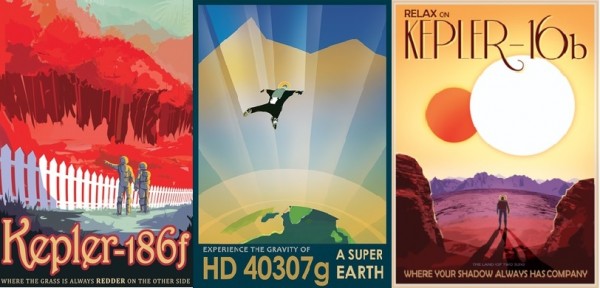NASA's Brilliant Space Travel Posters Invite You to Explore Earth-like Exoplanets
| Ana Verayo | | Jan 09, 2015 07:12 AM EST |
(Photo : NASA/JPL-Caltech) These space travel posters pay tribute to Kepler's roster of newly-found Earth like exoplanets.
NASA's Kepler spacecraft, which also serves as a space observatory searching for exoplanets, has discovered its 1,000th exoplanet outside the solar system.
To pay homage to these incredible space milestones, NASA presented a series of wonderfully depicted space travel posters for Kepler's newly found Earth-like exoplanets that encourages us humans to visit alien worlds in the near future.
Like Us on Facebook
Scientists believe that Kepler 186-f can sustain life since it's about the same size as the Earth and is in orbit in the habitable zone, which is the distance from its star that allows liquid water to form on its surface. This exoplanet's star is red, meaning the colors we see here on Earth will not be the same on 186-f.
Another Earth-like planet called HD 40307g is not as habitable as 186-f but its surface is also as rocky as the Earth's. This planet is larger than the Earth, about twice the size and possesses eight times more mass, indicative of stronger gravity.
The third planet is Kepler-16b that orbits around two stars in a binary star system. This particular exoplanet is apparently a gas planet similar to Saturn. Its temperature can be compared to dry ice.
The Kepler spacecraft is also a space telescope that hunts for exoplanets in distant star systems. When a planet move in front of its star, it causes the star's brightness to change a little bit making it dimmer than usual. When this change occurs, the spacecraft measures this changed brightness and confirms if this object is truly a planet in front of its sun.
To date, Kepler has found 1,004 confirmed exoplanets and is still searching for more beyond the cosmos. Its positioning wheels failed last year but scientists found a way to fix this problem by using radiation pressure from the Sun to position the telescope.
TagsNASA's Brilliant Space Travel Posters Invite You to Explore Real Earth-Like Planets, NASA, KEPLER, Exoplanets, earth-like planets, NASA posters space travel alien worlds exoplanets earth like
©2015 Chinatopix All rights reserved. Do not reproduce without permission
EDITOR'S PICKS
-

Did the Trump administration just announce plans for a trade war with ‘hostile’ China and Russia?
-

US Senate passes Taiwan travel bill slammed by China
-

As Yan Sihong’s family grieves, here are other Chinese students who went missing abroad. Some have never been found
-

Beijing blasts Western critics who ‘smear China’ with the term sharp power
-

China Envoy Seeks to Defuse Tensions With U.S. as a Trade War Brews
-

Singapore's Deputy PM Provides Bitcoin Vote of Confidence Amid China's Blanket Bans
-

China warns investors over risks in overseas virtual currency trading
-

Chinese government most trustworthy: survey
-

Kashima Antlers On Course For Back-To-Back Titles
MOST POPULAR
LATEST NEWS
Zhou Yongkang: China's Former Security Chief Sentenced to Life in Prison

China's former Chief of the Ministry of Public Security, Zhou Yongkang, has been given a life sentence after he was found guilty of abusing his office, bribery and deliberately ... Full Article
TRENDING STORY

China Pork Prices Expected to Stabilize As The Supplies Recover

Elephone P9000 Smartphone is now on Sale on Amazon India

There's a Big Chance Cliffhangers Won't Still Be Resolved When Grey's Anatomy Season 13 Returns

Supreme Court Ruled on Samsung vs Apple Dispute for Patent Infringement

Microsoft Surface Pro 5 Rumors and Release Date: What is the Latest?










